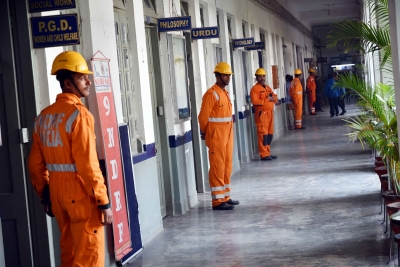All 16 NDRF battalions, 4 new bases to be operational by next year
By IANS | Published: November 7, 2021 07:42 PM2021-11-07T19:42:08+5:302021-11-07T20:00:09+5:30
New Delhi, Nov 7 With an aim to provide better rescue and relief measures to people in the ...

All 16 NDRF battalions, 4 new bases to be operational by next year
New Delhi, Nov 7 With an aim to provide better rescue and relief measures to people in the face of natural disasters like floods and cyclones, four additional battalions of National Disaster Response Force (NDRF) will be fully operational by the middle of next year with four additional bases in the National Capital Region (NCR), Jammu and Kashmir, Himachal Pradesh and Uttarakhand.
The four additional battalions will take the total number of NDRF battalions to 16.
After obtaining approval from the Union Cabinet, the Union Home Ministry had in 2018 sanctioned the raising of four additional battalions for NDRF, including two from Indo-Tibetan Border Police (ITBP), one from Assam Rifles and one from Border Security Force (BSF).
Of the two ITBP battalions, one each will be placed in Uttarakhand and Himachal Pradesh while the other two raised from BSF and Assam Rifle will have their bases in Jammu and Kashmir and NCR, respectively, officials in the force said, adding that most of the battalions under training will complete their specialised course soon and will be ready for deployment.
As of now, 12 battalions are fully operational with their bases in Guwahati, Nadia (West Bengal), Cuttack, Velore, Pune, Vadodara, Bhatinda, Ghaziabad, Patna, Guntur (Andhra Pradesh), Varanasi and Itanagar.
After the induction of four newly-raised battalions, over 4,500 trained personnel will be added to the strength of NDRF, an official said.
Normally, one battalion consists of 1,149 personnel with a specialised search and rescue team, paramedics, electric, technic and a dog squad for rescue operations.
For better and quick response to natural calamities, the NDRF in 2016 had moved a proposal to create an air wing but it was declined by the government. Air transport is provided by the Indian Air Force in case of immediate deployment.
Created in 2006 under the Disaster Management Act, 2005, the NDRF under the Union Home Ministry has been the backbone of relief and rescue operations in the country. Be it the floods caused by glacial outburst in Uttarakhand in February this year, Cyclone Yaas in Odisha and West Bengal, Cyclone Taukte or any flood situation arising out of heavy rains in many parts of the country, the forces immediately deployed their battalions for relief and rescue operations.
As a part of proactive measures in the monsoon season, 117 self-contained, fully-equipped flood rescue NDRF teams comprising more than 3,000 rescuers have been pre-positioned in various flood-prone areas in 29 states/UTs across the country.
The rescue teams were also deployed during the heavy rains in Uttarakhand, Gujarat, Maharashtra, Uttar Pradesh, Himachal Pradesh and other parts of the country in the months of August and September this year.
For rescue and relief work during the recent floods caused by cloudburst in Uttarakhand, 17 self-contained teams of the NDRF were deployed there in consultation with the state authorities, which evacuated more than 1,300 stranded people from Udham Singh Nagar and Nainital besides distributing relief materials to the people.
Training being one of the most important attributes for an efficient force, the Centre has set up a National Institute of Excellence for Search and Rescue in Nagpur.
With an aim to understand the best practices of disaster relief of other countries, the force also joins exercises with other countries like China, Finland, Korea, Malaysia and Singapore. It has also been part of joint training exercises in New Zealand, Switzerland, the US and Tehran to learn the best practices to prevent natural disasters.
It also organises various national and international symposium on disaster relief and discusses the impending threats like cascading effects of disaster events in the Himalayan region, including landslides, cloudbursts, earthquakes and glacial lake outburst floods (GLOFs)
Disclaimer: This post has been auto-published from an agency feed without any modifications to the text and has not been reviewed by an editor
Open in app